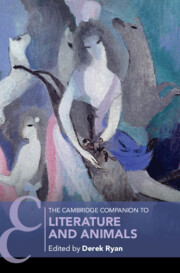Book contents
- The Cambridge Companion to Literature and Animals
- The Cambridge Companion to Literature and Animals
- Copyright page
- Contents
- Figures
- Contributors
- Introduction
- Part I Literary Periods
- Chapter 1 Middle Ages
- Chapter 2 Early Modern
- Chapter 3 Eighteenth Century
- Chapter 4 Romantic
- Chapter 5 Victorian
- Chapter 6 Modernist
- Chapter 7 Contemporary
- Part II Contexts and Controversies
- Select Bibliography
- Index
- Cambridge Companions To …
Chapter 2 - Early Modern
Flesh
from Part I - Literary Periods
Published online by Cambridge University Press: 26 October 2023
- The Cambridge Companion to Literature and Animals
- The Cambridge Companion to Literature and Animals
- Copyright page
- Contents
- Figures
- Contributors
- Introduction
- Part I Literary Periods
- Chapter 1 Middle Ages
- Chapter 2 Early Modern
- Chapter 3 Eighteenth Century
- Chapter 4 Romantic
- Chapter 5 Victorian
- Chapter 6 Modernist
- Chapter 7 Contemporary
- Part II Contexts and Controversies
- Select Bibliography
- Index
- Cambridge Companions To …
Summary
This chapter reads Hamlet in the light of debates in early modern animal studies, arguing that it is a play that responds to contemporary religious and philosophical questions about the distinction between humans and animals in its representation of flesh and of death. In particular, it focuses on ideas about the difference between human and animal death, and sees in Hamlet a challenge to the assumption of human immortality, reading human fleshiness – our edibility – as lying at the core of the play’s contemplations. In what is often regarded as Shakespeare’s key exploration of “the human,” the chapter argues that what can be found is a conception of our species that offers a challenge to the anthropocentrism of the early modern period, but also of our own.
- Type
- Chapter
- Information
- The Cambridge Companion to Literature and Animals , pp. 38 - 56Publisher: Cambridge University PressPrint publication year: 2023

